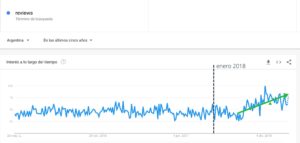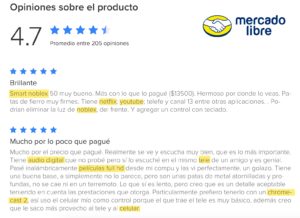How working reviews into your SEO & product strategies can be your best tool for e-commerce to sell more.
They say that facing our fears makes us grow as people.
Overcoming fear and implementing a product review strategy grows our sales.
Reviews are an almost perfect mixture of SEO & sales. It can help us rank for the terms most relevant to our niche, and build trust that generates conversions & all in a scalable way.
Users increasingly trust reviews. According to a study by Search Engine Land, 88% of people trust an online review as much as a personal recommendation.
The demand for this tool is reflected in the demand for reviews in Google searches.
Google Trends shows how in the last two years the relevance of “reviews” in Google is growing:

The studies and the metrics indicate that reviews must be more and more relevant
Studies & metrics indicate that reviews should be more and more relevant to improve our e-commerce and increase our conversion rate.
Here are 4 points to keep in mind for our review strategy & what we should prioritize for it:
Trust = Conversion
The foundation of any kind of transaction or negotiation is trust. For online product sales, trust is even more important (and more difficult to generate!).
We have to understand that the content of our e-commerce is our physical store “salesperson”. What information we communicate, where we communicate it, and how we communicate it can be (and should be!) your main differential vs. the competition.
Reviews are comments or recommendations made by users who have already interacted with your product or service. It allows the potential customer to better understand what they are buying and knowing this, minimizes the margin of error of “expectation vs. reality.”
As consumers, we are aware that the products that we buy and the services that we hire are not perfect. And as digital experts, we know that from the brand, we can never highlight its deficiencies.
As people, we know that understanding everything that goes into the purchase of a product or service (especially when it has a high value) is key in the decision to buy.
To be able to show our products/services with our technical explanation, to accompany it with images, with videos, and to be able to accompany it with real product testimonials is the closest thing to transforming an online shopping experience to simply an excellent shopping experience.
SEO is content
Generating excellent content is the key to your SEO positioning & to beating the competition.
While there are technical aspects of SEO, all strategies end up revolving around content creation, optimization, or accessibility.
When it comes to reviews, we know that users value reviews with text over those that are just stars. A Fan and Fuel study found that 73% of users prefer a written review vs. just a rating.
Although we can work with short-tail & long-tail, brand or non-brand, primary or secondary keywords from product cards, categories, or blogs… these sources have limitations.
Mercado Libre, one of the best SEO optimized platforms in LATAM launched its review strategy almost 5 years ago thinking about improving the shopping experience and filling a gap in its SEO strategy, and content.

The reviews are generated by your clients. This means that your clients generate content with keywords that Google uses to rank your site. Let’s see how these two reviews contain a lot of keywords:

This transforms the reviews into one of the richest sources of unique and valuable content for SEO.
Bad reviews are good reviews
The increase in the frequency that users use reviews is teaching us a few things.
Users are realizing the “truth” behind 5-star reviews. They understand that when they see 5 stars on a product/service, they think one of two alternatives: a) this product has no reviews or b) the owners or employees themselves are generating the reviews.
Receiving a negative (or not as positive as we want) review is not a shot in the foot for your brand’s reputation; it is an opportunity to understand where there is room for improvement and an opportunity to potentially build customer loyalty.
Non-response is not a solution for reviews we don’t like and the key to making your reviews contribute & contribute more to your business is to respond to negative comments.
Ignoring a negative review runs the risk of appearing that we don’t care about our customers’ opinions or that we are not willing to help them.
Imagine the relevance of responding to reviews that Google takes as a factor to position your Google My Business.
In addition, that a brand responds to a customer’s concern or dissatisfaction is encouraging for a potential customer.
Competitive Advantage
Now, we understand the value & potential of a review strategy, but how do we put it into practice?
Here are 6 tips to apply, optimize & make the most of your review strategy:
- Enable reviews on your e-commerce product pages: Retailers who choose not to display this information run the risk of that sale going to a competitor.
- Capitalize on your negative reviews: Although it sounds counterproductive, allowing & responding to negative reviews helps us build credibility & trust.
- Prioritize the generation of reviews for products that have a low number of reviews: The goal is for all your products to have a handful of reviews, not just your most relevant products.
- Prioritize even more the generation of reviews for high ticket value products: You can help drive a sale by removing the fear or lack of knowledge about a product by sharing experiences from other customers.
- Quality > Quantity: a 4-star review of 110 words has much more value for SEO & customer trust than 5 reviews that say “good product”.
Identify reviews qualified with “Certified User”: Identifying customers with “certification seals” (similar to Trip Advisor for example) increases the probability of purchase by 15%.
I hope these tips will help you leverage reviews in your digital strategy and increase your sales!



